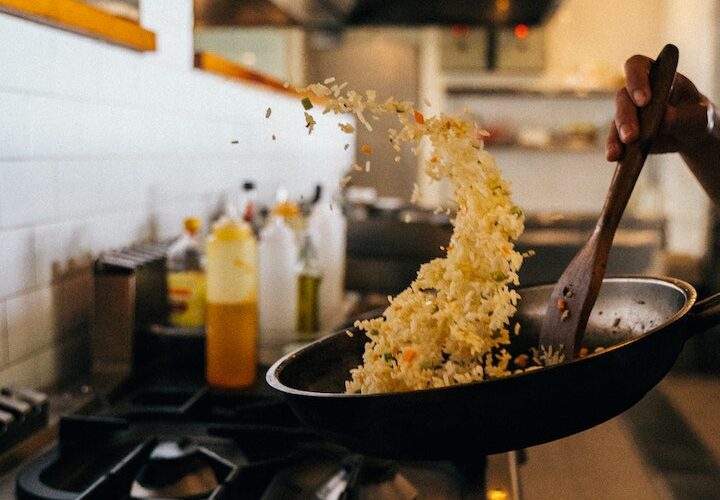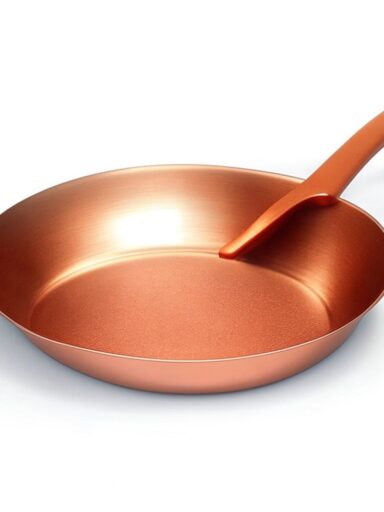Discover the best pan to cook rice and tips for perfect preparation. Get expert insights on non-stick, stainless steel, and cast iron pans.
The Importance of Cooking Rice Properly
Rice is a staple food in many cultures around the world. It is versatile, easy to prepare, and can be paired with a variety of dishes.
However, cooking rice can be an intimidating task for many people. One of the most important aspects of cooking rice properly is choosing the right pan.
The type and quality of the pan you use can greatly affect the texture and taste of your rice. Cooking rice improperly can result in undercooked or mushy rice that lacks flavor or has an unpleasant texture.
Additionally, overcooking rice can cause it to become sticky or clumpy. This is why it’s important to choose a high-quality pan that ensures your rice cooks evenly and comes out perfectly every time.
Overview of the Best Pan-to-Cook Rice
When it comes to choosing a pan for cooking rice, there are several factors to consider such as material, size, and shape. There are three main types of pans available: non-stick pans, stainless steel pans, and cast iron pans. Non-stick pans are coated with a layer of Teflon or ceramic material that prevents food from sticking to them while cooking.
Stainless steel pans are durable and long-lasting but may require additional cleaning effort because they tend to stick more than non-stick pans. Cast iron pans are heavy-duty cookware pieces that retain heat well but can be more difficult to clean than other materials.
Each type of pan has its own advantages and disadvantages depending on your specific needs and preferences when it comes to cooking rice. In this article, we will dive deeper into each type of pan so you can make an informed decision when purchasing your next kitchen essential – the best pan for cooking perfect rice every time!
Types of Pans for Cooking Rice
When it comes to cooking rice, the type of pan you choose can significantly impact the final result. There are different types of pans available in the market, each with its own advantages and disadvantages. The three most popular types of pans for cooking rice are non-stick pans, stainless steel pans, and cast iron pans.
Non-Stick Pans
Non-stick pans are a popular choice when it comes to cooking rice due to their easy-to-clean surface. The non-stick coating ensures that the rice grains do not stick to the pan, resulting in a hassle-free cooking experience.
This type of pan is also perfect for those who are new to cooking as it requires minimal oil or butter to prevent sticking. Despite their convenience, non-stick pans have their drawbacks.
Over time, the non-stick coating can wear off, exposing harmful chemicals that can leach into your food. It is also important to note that these pans should only be used with wooden or silicone utensils as metal utensils can scratch and damage the surface.
Stainless Steel Pans
Stainless steel pans are another popular option for cooking rice due to their durability and long-lasting nature. They do not react with acidic foods like tomatoes or vinegar and maintain their shiny appearance even with frequent use. Stainless steel also has excellent heat distribution properties that allow even heat distribution during cooking.
However, stainless steel has one major drawback – it is prone to sticking when used without oil or butter. Therefore, it is essential always to add some fat before adding your rice grains into this type of pan.
Cast Iron Pans
Cast iron pans have been used for centuries as they retain heat well and add flavor to food due to a natural seasoning process that occurs over time with repeated use. These types of pans are versatile and can be used on the stovetop, in the oven, or over a campfire. While cast iron pans require seasoning and maintenance, they are incredibly durable and long-lasting.
The seasoning process results in a non-stick surface that makes cooking rice easy. However, cast iron pans are also prone to rusting if not properly cleaned and dried after each use.
Advantages and Disadvantages of Each Type of Pan
Non-Stick Pans: Easy to clean, but can be prone to scratching and flaking.
Non-stick pans are a popular choice for cooking rice due to their non-stick coating, which allows for easy cleaning. They also require less oil or butter, making them a healthier option. However, non-stick pans can be prone to scratching and flaking, especially with metal utensils or high heat.
This can cause harmful chemicals to leach into the food. Some non-stick coatings also have a limited lifespan and need replacing after regular use.
To extend the life of your non-stick pan when cooking rice, it is important to avoid using metal utensils and cook on medium heat only. Consider investing in a high-quality non-stick pan with a thicker coating that is less likely to scratch or flake off.
Stainless Steel Pans: Durable and long-lasting, but can be prone to sticking.
Stainless steel pans are known for their durability and long-lasting quality. They offer even heating across the surface of the pan, making them ideal for cooking rice evenly without burning it.
However, stainless steel pans tend to stick more than other types of pans if not greased properly. This makes them slightly less convenient when it comes time for clean-up.
One way to reduce sticking when using stainless steel pans for cooking rice is by first heating up the pan before adding any oil or butter. You can also add more liquid than you typically would when cooking rice in order to create more steam that will prevent sticking.
Cast Iron Pans: Retain heat well and can add flavor but require seasoning and maintenance.
Cast iron pans are another popular option for cooking rice due to their ability to retain heat well even after removing them from the heat source. Cast iron pans can also add a unique flavor to the food that is cooked in them.
However, they require regular seasoning and maintenance to prevent rusting and ensure that the non-stick properties of the pan are maintained. To maintain your cast iron pan when cooking rice, avoid using soap when cleaning it, as this can strip away the seasoning.
Instead, use hot water and a stiff brush to clean any residue off of the surface. Additionally, be sure to dry your cast iron pan immediately after washing it to prevent rusting.
Features to Look for in a Rice Cooking Pan
Size:
When choosing a pan for cooking rice, size is an important consideration. The size of the pan should be selected according to the amount of rice you want to cook. A larger pan is perfect for cooking larger quantities while a smaller one is best suited for small amounts.
In addition, the depth of the pan should also be considered as it can affect how well the rice cooks. Too shallow a pan may result in unevenly cooked rice, while too deep a pan may make it difficult to stir or fluff up the cooked rice.
Shape:
The shape of the pan can also play an important role in how well your rice cooks. A flat-bottomed and wide-based pan is ideal as it allows heat to distribute evenly throughout the entire surface area of the pot.
This means that each grain will be cooked uniformly and will not stick together. Additionally, pans with rounded bottoms or edges can make stirring more difficult and increase the risk of burning.
Lid:
An integral part of any good rice-cooking experience is having a good lid that fits tightly on your cooking pot. The purpose of this lid is twofold; first, it traps steam inside which helps cook the grains evenly, and secondly, it keeps aromas locked inside which adds flavor and aroma to your dish as you lift off the lid once done cooking.
When selecting a pot for cooking your favorite type of rice at home, there are numerous factors that need careful consideration including size capacity, shape, and lid compatibility with your pot – all working together to give you perfect fluffy grains every time!
Tips for Cooking Rice in a Pan
Washing the Rice Before Cooking It
Washing rice before cooking is important because it removes excess starch and debris. This process also helps to remove any impurities or chemicals that may have been used in processing the rice.
The easiest way to do this is to rinse the rice under cold running water until the water runs clear. Once rinsed, let the rice soak in water for at least 30 minutes before cooking.
The ratio of Water to Rice
Getting the right ratio of water to rice is crucial when cooking rice in a pan. Too much water and you end up with mushy, overcooked rice, while too little can result in undercooked grains that are hard and crunchy.
Generally, it is best to use two cups of water for every one cup of uncooked rice. However, this can vary depending on the type of rice being used (e.g., brown vs white) and personal preference.
Cooking Time
Cooking time can vary depending on factors such as altitude, humidity, and the type of stove being used. Once you have added the appropriate amount of water and brought it to a boil over high heat, reduce it to low heat and cover it tightly with a lid. White rice typically takes 18-20 minutes to cook while brown rice takes 35-40 minutes or longer depending on how soft one wants the grains.
Avoid opening the lid while cooking as this will disrupt the steaming process which plays an integral role in softening your grains evenly. Overall, taking care of these steps will ensure that your pan-cooked rice comes out fluffy and delicious every time!
Conclusion
Choose Wisely for the Perfect Rice
Choosing the right pan for cooking rice is crucial to achieving the perfect consistency and flavor every time. The type of pan you use can affect how your rice turns out and can be the difference between fluffy, perfectly cooked grains and a sticky mess.
Therefore, it is essential to consider the features of different types of pans and choose one that suits your needs. If you want a convenient and easy-to-clean option, non-stick pans are an excellent choice.
They are low maintenance and require little oil or water to cook rice. However, they can be prone to scratching or flaking over time.
On the other hand, stainless steel pans are durable and long-lasting but may require more oil or water to cook rice without sticking. Cast iron pans offer excellent heat retention but require seasoning before use and ongoing maintenance to prevent rusting or deterioration.
Recommendation: Best Pan for Cooking Rice
Based on our analysis of different types of pans for cooking rice, we recommend using a non-stick pan with a sturdy lid for optimal results. Non-stick pans are easy to clean, require little oil or water, and prevent sticking during cooking.
When selecting a non-stick pan for cooking rice, look for one made with high-quality materials that will last over time without scratching or flaking. Additionally, choose a size that is appropriate for your needs – too large or too small could affect how your rice cooks.
By considering these factors when selecting the best pan to cook rice, you can achieve perfect results every time with minimal effort. Happy cooking!




